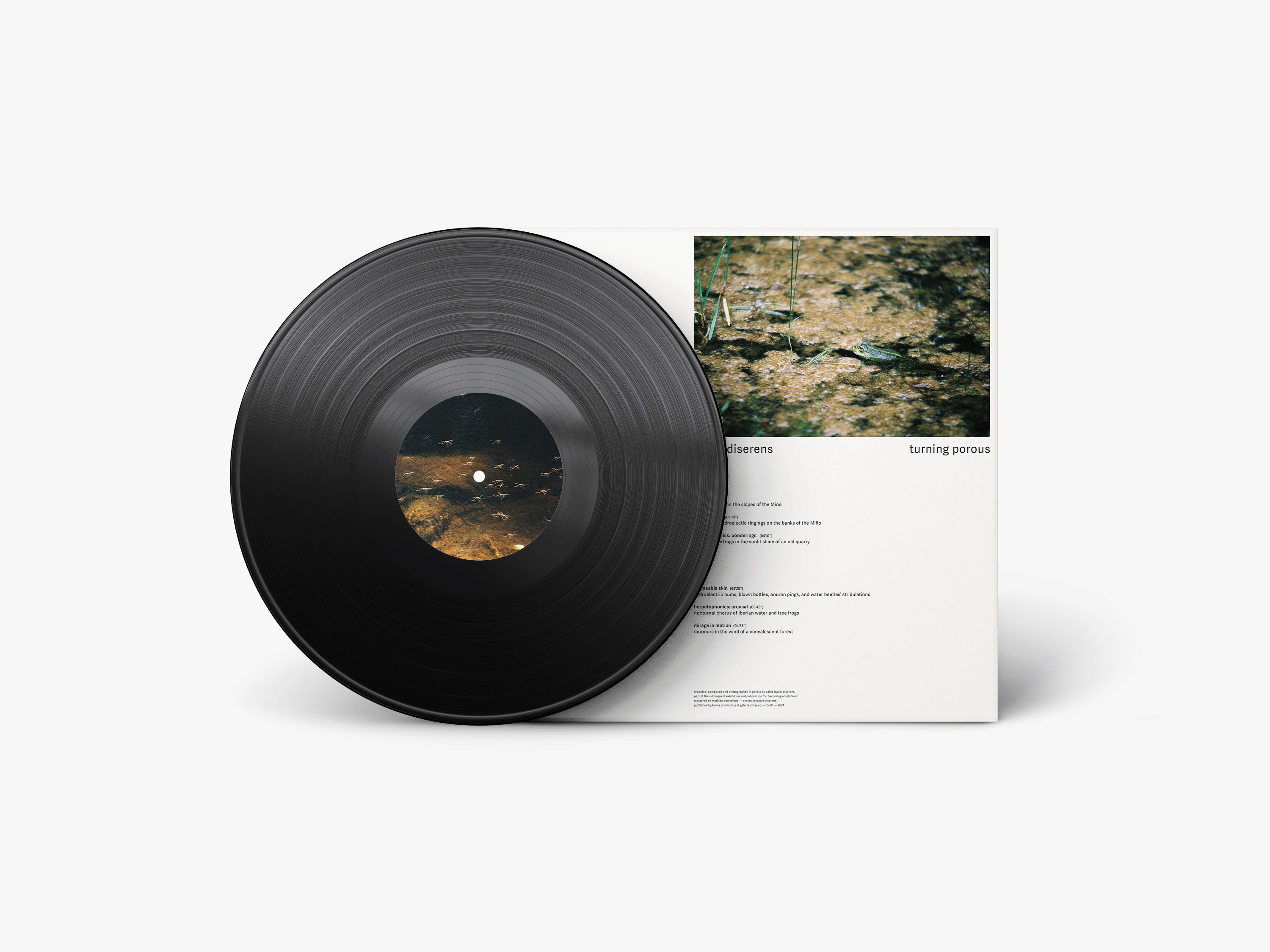turning porous
2024
album of amphibious and hydrographic recordings
recorded and composed during a residency with Galería Vilaseco
LP & digital
published by forms of minutiae & Galería Vilaseco

As part of the upcoming solo exhibition and publication “on becoming amphibian”, forms of minutiae and Galería Vilaseco present "turning porous", a gathering of amphibious and hydrographic acoustics by field recordist, artist, and forms of minutiae’s co-founder Pablo Diserens.
Invited to live and work for a two-month period in Galicia, the verdant region of Spain’s northwest, Pablo Diserens spent days and nights inhabiting the region’s freshwaters in the hope of merging with the local amphibian communities. All ears, they adopted a series of listening postures while deploying a range of visual and sound recording techniques. Gradually dissolving in the herpetofauna, Diserens toyed with the boundaries of human experience by engaging in somatic play and perceptual reframing. This resulted in an altered sensing of the present as existence funneled through embodied amphibious realities. The subsequent exhibition and publication “on becoming amphibian” and the album “turning porous” form a body of work that reflects this permeable morphing while inviting listeners into the vulnerable soundscapes of Galicia’s aqueous ecologies.
Over the course of six tracks, anuran calls, insect stridulations, bat clicks, avian songs, hydroelectric hums, and wind-borne tones occur. Frog recordings and dronesque soundscape compositions alternate, drawing us into the sonic intricacies of the region’s ponds and rivers while hinting at site-specific musics. Closeness is felt throughout, as tracks bear a sense of intimate positioning flirting with physical contact.
Enamored with frogs and concerned with their well-being, Diserens gives the stage to the anuran world. Amphibians are known as indicator species. Their health and extreme sensitivity to environmental changes speak volumes on the state of the planet. So much so that their presence (or lack of) can be used to monitor the health of a habitat. “alytes” opens the album with the deliciously minute calls of common midwife toads (Alytes obstetricans) recorded on the slopes of the Rio Miño. Placed extremely close to the toads, microphones pick up prudent nocturnal pings intertwining over time into a delicate tonal tapestry. A bewitching music of some sort. Aptly named, the two “herpetophonics” tickle the ears and dilate the pores as the boisterous calls of Iberian water frogs (Pelophylax perezi) and Iberian tree frogs (Hyla molleri) radiate from former quarries. As listeners melt in these aroused soundscapes, pings, ribbits and chirps swell with hints of meaning as if we began to fathom and hear them as a language — an anuran semantic.
“riparian zone” paints a portrait of the Rio Miño by merging animal voices and anthropogenic vibrations heard along the river’s slopes. In a quasi-circadian curvature, alytes, crickets, grasshoppers, bats and birds merge into a polyrhythmic soundscape made of clicks, pings, and zips. These are cushioned by the dronesque confluence of murmuring insects and the static hums of a dam’s hydroelectric plant—which tonal resonances gradually shift as the microphones move closer and away from the drone’s source. Throughout the track, non-human presences ebb and flow from the constant buzz of the hydraulic technologies scarring the landscape. As dusk reaches dawn, a bird reclaims the foreground by attacking the microphones and giving way to the gripping clatter of storks.
For Diserens, sustained tones and rhythmic complexities hold a unique magnetism, even more so when such music is found discreetly existing in the world. “permeable skin” carries this sentiment with spellbinding delicacy. Water beetles stridulate and zip away under the surface of a frog-packed pond, unveiling the submerged pulses of the waters’ flip side. Tones rise from the hydroelectric structures further upstream, intertwining in a site-specific music charged with emotional ambiguity. Diserens responds by blowing into glass bottles, creating oscillations made of Helmholtz resonances. Finally, anuran pings join this microtonal chorus as it percolates with amphibience, liquifying listeners into a permeable state.
“mirage in motion” ends the album with an arcane opening. Somewhere between protruding boulders and contorted bodies of sick chestnut trees, the forest is visited by a gentle hum. As insects stridulate timidly, winds funnel through a cracked sylvan trunk to form soft blown tones, ebbing and flowing with the aerial currents.
All in all, “turning porous” oozes with the slime and intimacy of Diserens’ listening experience. They write in the adjacent publication: “I’m more frog than human these days”. A shapeshifting that is made audible through the imbrication of field recordings, dronesque forms, and hints of acoustic ecology. By inviting listeners to weave themselves with the fragile amphibian and riparian realities of Galicia, "turning porous" is an invitation to let the world in in a gesture of permeance. A murmur that calls for permeable and porous existence as a way of cohabiting with the critters of the ponds, and beyond.



︎
This album is an extension of Pablo Diserens' exhibition and publication "on becoming amphibian" with Galeria Vilaseco which will open and be published in the autumn of 2024. The book features a collection of daily poetic observations that recount Diserens’ sonic and non-human encounters as they search for anuran kinship and gently metamorphose into a creature of the ponds.
> 12” LP - 45rpm - 180g— limited edition of 200
> recorded and composed in galicia by pablo (rana) diserens
> photographs by pablo diserens
> part of the subsequent exhibition and publication "on becoming amphibian"
> mastered by mathieu bonnafous
> design by pablo diserens
> cut by dub plates & mastering — pressed by objects (manufacturing)
> curated by andrea franco
> made possible thanks to miriam vilaseco, lola fernández gómez, beatriz pérez pereira, silvia garcía-calvo, carolina núñez, rosa salamo otero, frederic griesbaum, and madelyn byrd
> published by forms of minutiae & galería vilaseco — fom11 — 2024